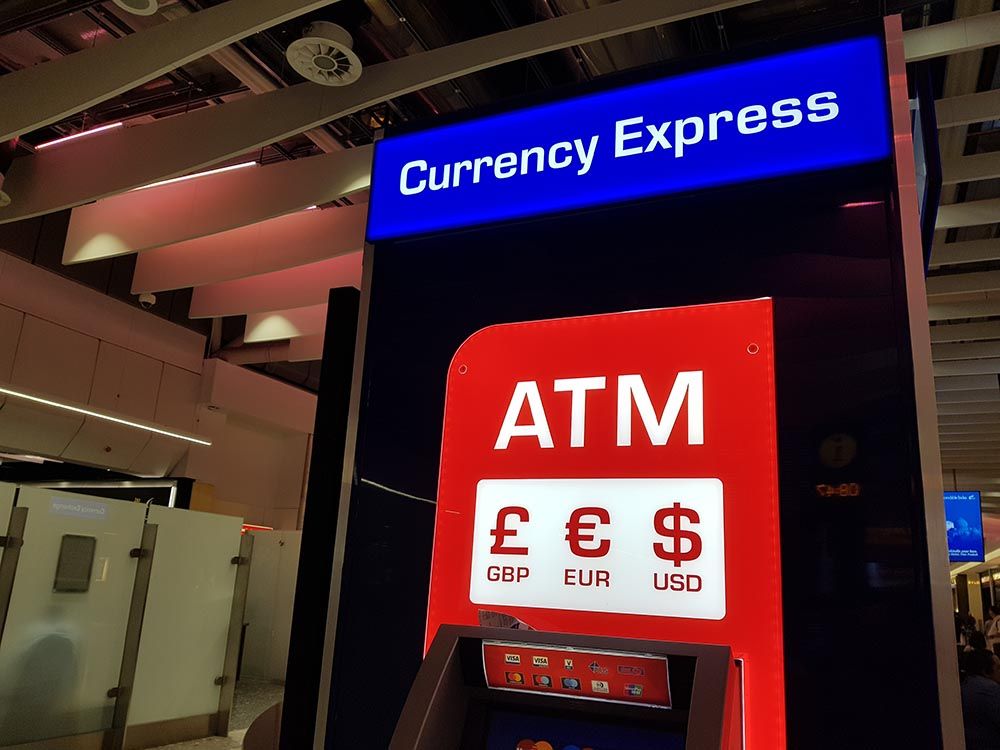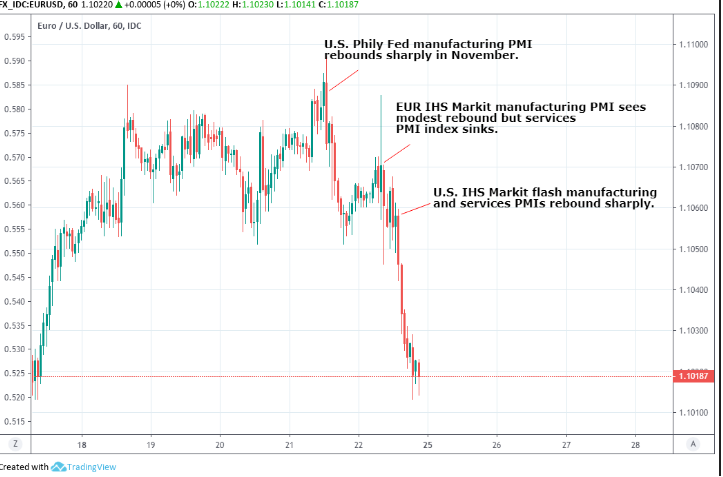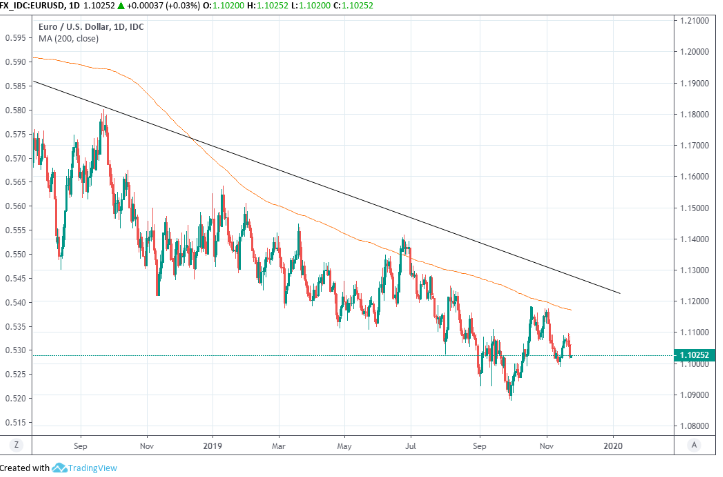EUR/USD Rate Week Ahead Forecast: Supported on Charts and Eyeing Top of Trend Channel
- Written by: James Skinner

Image © Pound Sterling Live
- EUR bruised by trade uncertainty and economic concerns.
- Ahead of action-packed week for EZ and U.S. economic data.
- Commerzbank says charts favour fresh push higher by EUR.
- China talks and U.S. economic data key to short-term price action.
The Euro received a drubbing at the hands of the U.S. Dollar last week, although some analysts say it should find support near current lows in the days ahead, before taking another run at a key resistance level on the charts.
Europe's single currency got off to a flying start last week but was ultimately undermined by stronger-than-expected U.S. economic data that emerged almost concurrently with weaker-than-anticipated Eurozone figures. Recent data has brought back into focus the divergence between fortunes of the U.S. and Eurozone economies, which is an important driver of currency markets.
The Euro's strong start to last week led it into a test of the 55-day moving-average that has so-far acted like a resistance barrier around the 1.1087 level, although the subsequent retreat has now taken the single currency back below its 20-day moving-average of 1.1044. This has left just one layer of support around 1.0989 standing between the single currency and new lows for the year but technical analysts at Commerzbank say that level should hold.
"EUR/USD has started to erode the 55 day ma at 1.1087, but did not sustain the break. This slightly increases the risk of a retest of the 1.1180 recent high (favoured). Dips lower will find near term support offered by the 20 day ma at 1.1044 and will ideally remain contained by 1.0989, the recent low. Above 1.1180 will target the 1.1262 top of the channel and the 1.1359 200 week ma," says Karen Jones, Commerzbank's head of technical analysis.

Above: Euro-to-Dollar rate shown at hourly intervals.
Jones, who studies trends and momentum on the charts rather than economic fundamentals or anything like that, says it's possible the Euro could see one last leg down to the base of its downward sloping trend channel at 1.0865 and 1.0814 before making a recovery but that this is not her 'base case'.
Commerzbank bought the Euro-to-Dollar rate at 1.1075 and Jones said Friday that with the single currency now back at 1.1040, clients should take the opportunity to increase the size of the bet.
The bank has a 'stop loss' at 1.0985, which means walking away from the trade if that price is reached, but Jones says the Euro could ultimately take a run at the 200-day moving-average near to 1.1180 and the top of its 'trend channel' around 1.1265 over the coming weeks and months.

Above: EUR/USD at daily intervals. Orange line reflects 200-day moving-average, black line is 'top of channel'.
AA
The Euro: What to Watch
The Euro may be indicated higher by the charts but inflation figures, business surveys and the U.S.-China trade talks will be just as important as anything else in determining the trajectory of the currency over the coming days.
The Leibniz Institute for Economic Research (Ifo) Business Climate survey is out at 09:00 Monday at 0900 and markets are looking for the index to rise from 94.6 to 94.9, which would mark a second consecutive increase for the influential barometer of German economic activity. Last month the institute said the manufacturing slump, a key driver of the downturn in the economy, had come to an end and that the six-month outlook was brightening.
That followed a surprise pickup in factory orders in October and a slowing in the industrial production downturn which led some to hope that a full-on recovery could be lurking in the long grass of 2020. The Euro might receive a temporary boost Monday if November's Ifo survey retains the upbeat tone of the prior report although once published, U.S. economic numbers and the trade talks with China will dominate price action until Friday when November inflation figures are released at 10:00.
Consensus is looking for Eurozone inflation to have risen from 0.7% to 0.8% in November and for core inflation to have risen from 1.1% to 1.2%, although these will still leave both indices far beneath the European Central Bank (ECB) target of "close to, but below 2%". No matter the outcome, the inflation data will not change the fact that the ECB's interest rates are likely to remain at current or lower levels for an extended period,.
"The decline in the euro-zone Composite PMI for November reinforces our view that growth in the monetary union will deteriorate further in the coming months. With governments so far resisting pressure to loosen fiscal policy, we suspect that the burden of stimulating the economy will continue to fall on the ECB. This underpins our view that euro-zone bond yields and the euro will fall further between now and end-2020," says Simona Gambarini at Capital Economics.
The most prominent drivers of the Euro-Dollar rate this week will likely be President Donald Trump' decision on whether to sign the Hong Kong Human Rights and Democracy Act as well as the ebb and flow of information relating to the U.S.-China trade talks. After all, Europe's economy has arguably suffered more from the trade war than either of its two protagonists.
AA
The U.S. Dollar: What to Watch
The Dollar rose against most major rivals Friday, marking a fourth day of gains for the Dollar Index, although its trajectory in the coming days will be determined by economic figures and developments in the U.S.-China talks.
Consumer confidence figures and the October Chicago PMI will provide insight this week into the recent condition of U.S. households and manufacturers, although the personal consumption expenditures (PCE) price index for October is arguably the highlight of the week on the economic front.
The consumer confidence report is out at 15:00 Tuesday, the PMI at 14:45 Wednesday and the PCE index at 15:00 Wednesday. In the middle of all this, core durable goods orders data for the month of October will be released at 13:30 Wednesday. That's important component of business invesment, which matters for final quarter GDP growth.
The PCE index is the preferred inflation measure of the Federal Reserve (Fed) and has been running below the 2% target throughout 2019. It declined from 1.4% to 1.3% in September so further weakness in October might incite speculation about more rate cuts up ahead.
"Overall, we see little chance of a turnaround in the recent direction of data in either the eurozone or the US, which should ultimately leave EUR/USD mostly driven by the USD safe-haven flows in relation to trade sentiment," says Chris Turner, head of FX strategy at ING.
Minutes of the October Fed meeting confirmed last week that sentiments expressed earlier in Washington by Chairman Jerome Powell are widely held on the bank's committee of rate setters, with many on the FOMC agreeing that rates are "well calibrated".
The Fed has signalled that its rate cutting cycle is now over for the time being, which has supported the Dollar through much of November and was a factor at play in price action last week. However, most significant for the Dollar in the week ahead will be the next developments in the U.S.-China trade talks.
Investors will be particularly keen to see if President Donald Trump will put his signature to the Hong Kong Human Rights and Democracy Act that passed through Congress last week, because it has scope to further complicate the path toward the 'phase one deal' U.S. and China are attempting to formalise.
Last week, U.S. negotiators turned down an invitation to visit Beijing for talks over the Thanksgiving period, although Vice Premier Liu He was still reported Thursday to be "cautiously optimistic" about the prospect of reaching a deal with the White House.
The Hong Kong bill, which is expected to become law regardless of whether Trump signs it, threatens to remove the city's special trade status and impose sanctions on some Chinese officials if its independence is undermined. Its passing by lawmakers drew a rebuke from China and threats of an unspecified retaliation if it makes it onto the statute book so it's possible that any signing of it could have adverse consequences for the trade talks.
Time to move your money? Get 3-5% more currency than your bank would offer by using the services of a foreign exchange specialist. A specialist payments provider can deliver you an exchange rate closer to the real market rate than your bank would, thereby saving you substantial quantities of currency. Find out more here.
* Advertisement




